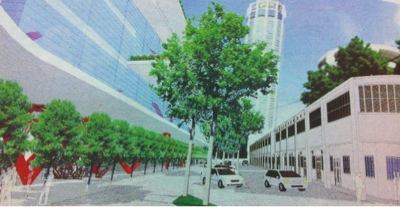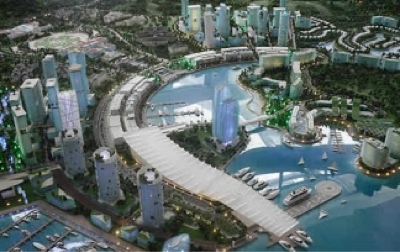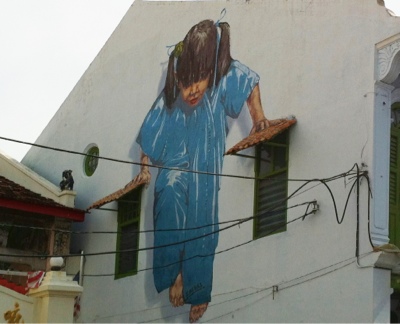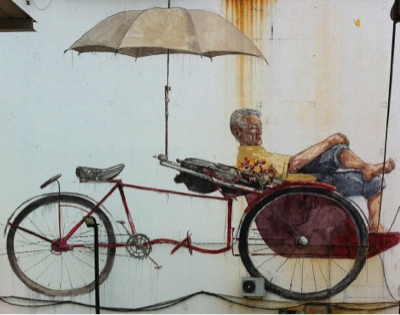Monday August 6, 2012
Penang Property Talk Guru | Penang Investment | Rising rental yields...Restore or renovate?
[The rental value of prime property in Georgetown's heritage zones has climbed at least 50% over the past 12 months]
HERITAGE buildings in George Town continue to draw investment interest, with renovated shophouses in the heritage core and buffer zones chalking up an increase of 50% to 100% in rental value since last year.
But is all this rush to cash in on tourist dollars resulting in unsafe buildings that do not meet fire safety regulations?
In Penang, a“heritage building” refers to pre-war structure, such as traditional Chinese shophouse, built before 1945, the year World War II ended.
For a long time, the rental yield of old shophouses was rather low, typically fetching a couple of hundred ringgit for residential use and several hundred ringgit for business use.
In George Town, shophouse property can either have residential or commercial status within the same street.
But in recent years, with the increase in low-cost flights to the island and the influx of tourists — bother domestic and foreign — new investors have been attracted to establish mainly boutique or budget hotels in shophouses.
A check on online property portals reveal that typical shophouse property in the prime commercial areas of George Town are not longer within the RM1,500 to RM2,000 rental range but at least RM3,000 per month.
Tenancy agreement
Previously, we have reported on the steep rise in the value of heritage buildings in George Town due to the new-found demand for property with a bit of history and architectural appeal.
And the latest news is that such increases have prompted stakeholders — especially clan and religious associations that own many such properties — to re-evaluate their rental agreements with tenants. One business affected by the rise in property value is the Alpha Utara Gallery established by veteran artist Khoo Sui Hoe, 73. Located in a renovated, pre-war shophouse at Lebuh China, the gallery has been operating there for the past eight years.
“My rent was RM2,000 when I first started here,” explained Khoo, who has been an ardent promoter of art in Penang.
“But with the nature of this business, it will be hard to keep up with any increase.”
However, according to Khoo, he wasn’t even informed of any rent increase.
He was only told that the association wanted to terminate the rent agreement and take possession of the premises. Apparently, others were waiting in the wings. Khoo will move out by the end of September.
Word in the neighbourhood is that such a splendid double-storey shophouse in Lebuh China, near the Kwan Im Teng Temple, can fetch at least RM4,000 a month.
According to an informed source, even RM4,000 is considered reasonable, as there are properties nearby, up for rent at between RM5,000 and RM6,000 monthly.
For instance, a newly-completed triple-storey, shophouse property — spanning three adjoining units — is commanding rent of RM12,000 a month. The tenancy agreement purportedly extends to 25 years and the cost of restoration is being borne by the tenant.
However, not all shophouse property located in George Town can fetch such prices — not yet anyway. The popular areas for new businesses seem to be centred on the heritage core zone and buffer zone where tourists throng.
Love Lane
While Jalan Chulia and Lorong Love (Love Lane) have long been favoured by back packers in the past, more chic and pricier lodgings and eateries have sprouted within and beyond the inner city neighbourhood.
Even the early “heritage” enterprises such as the Little Shanghai Heritage Row at the junction of Jalan Nagor and Jalan Bawasah have been overshadowed by recent developments closer to the heritage zones.
Typically, many of the old buildings located in areas such as Lebuh Armenian, Jalan Muntri, Lebuh China and Lebuh Pantai (Beach Street), have been converted into trendy cafes, restaurants and art galleries as well as “boutique” or “budget” hotels with a couple of “Homestay” establishments joining the bandwagon.
Even places further afield from the heritage zones such as Jalan Hutton and Jalan Clove Hall have relatively new businesses in heritage buildings.
Within the past year, more tourism-related enterprises have mushroomed, including along Jalan Pintal Tali (Rope Walk), Lebuh Campbell, Lebuh Cintra, Jalan Masjid Kapitan Keling and Lebuh Noordin.And soon to join the ranks will be new business establishments at Lebuh Melayu, Lorong Ikan, Lorong Lumut, Lorong Stewart, Lebuh China and Jalan A.S. Mansoor (Jalan Sekarat).
What has been mentioned, refers mainly to old shophouses converted to lodgings with limited accommodations ranging from five rooms to a dozen or two, depending on how many adjoining shophouses are involved.
St Giles
Incidentally, dwarfing all these little “boutique” developments will be IGB Corp Bhd’s St Giles Hotel being built on five lots facing Traders Hotel along Jalan Magazine, a road parallel to Lebuh Noordin. The 31-storey building will have 576 rooms. It will be managed by Cititel Hotel Management. But St Giles will be marketed at a higher class than Cititel.
Commercial use
Anyway, buying or investing in an old shophouse is one thing. The hassles begin when the owner or stakeholder tries to restore or renovate the property for a business venture. There are so many confusing and conflicting regulations involving regulatory bodies, including the local municipal council, Fire & Rescue Department (Bomba) and even George Town World Heritage Incorporated.
Applying for a permit to restore your property — especially if it is located within the heritage zones (core and buffer) — could take at least eight months to a year. This is despite all the talk about the local authorities’ one-stop approval centre.
If you want to apply for a change of status from residential use to commercial use, the process is long and tedious. Actually, first and foremost, you have to submit all your architectural plans to Bomba for approval. And Bomba’s requirements may not necessarily conform to heritage conservation guidelines.
A property owner on Lebuh Melayu complained that it took him two long years to get the approval to convert his shophouse to a hotel. Apparently, his building and material costs went up three times while waiting. Other property owners who try to do things the right way have complained of illogical requirements.
One property owner was made to build a enormous water storage tank in his shophouse property that took up half his kitchen space. He was also asked to provide parking space in front of his shophouse property along busy Lebuh Campbell, an impossible requirement.
When challenged to show the actual bylaw requiring this, the official concerned could not respond.
Those who have yet to be issued a renovation permit have also complained of harassment when they try to dispose of rubbish from their newly vacated property.
One owner at Jalan Pintal Tali was recently told that clearing rubbish also require a permit!
Bomba
Nevertheless, a visit to Bomba Penang headquarters in Prai revealed that certain property owners of heritage buildings in George Town have not renovated or restored their property to conform to fire safety regulations. This is simply because they did not apply for Bomba’s approval.
According to Bomba Penang director Azmi Tamat, 55, owners wanting to convert their property to commercial use have to abide by the regulations stipulated in the Uniform Building Bylaws 1984 that apply everywhere in the country.
“We understand the situation of property owners, but not all heritage properties can be approved for use as hotels or restaurants,” said Azmi, a veteran of the fire department for the past 35 years.
“We don’t want a situation in which a tourist or anyone is killed in a fire in one of those boutique or budget hotels. We have to adopt preventive measures before such a situation occurs. And the regulations are clearly spelt out under the bylaws,” pointed out the fire chief.
Two exits
He said that any property for hotel use must have two exits — front and back. The maximum distance to the exit is nine metres. And the staircase must face the front entrance. This is contrary to the traditional layout of a shophouse where the staircase faces the back.
Wall and flooring material must be fire retardant or resistant, which means that the floor boards on the upper level have to be underlaid with such a material. Doors have to be fire-rated and must be able to withstand heat and flames for at least one hour.
Azmi explained that during an emergency, local workers may be familiar with the building structure and escape, but a visitor especially a foreigner, may not find a way out. Also, a fire victim could also be easily overcome with smoke.
Architects
Owners of old shophouses should adopt both active and passive measures to prevent fires from occurring or spreading, advised Azmi.
Besides installing smoke, heat and fire detectors as well as a smoke extraction system, hose reels, emergency lights, exit signs and fire extinguishers, the staff of commercial premises must attend a course on emergency response conducted by Bomba. A company representative such as the receptionist, chef or security staff need only attend the three-day class once. The participant is then expected to train his or her own colleagues.
Said Azmi: “We know that operators of hotels in heritage buildings don’t make that much and we sympathise with them, but where lives are at stake, we can’t take chances. Their qualified architects know the requirements and procedures, therefore, they should submit their plans to us to ensure everyone’s safety.”
But like everything else, there is a loophole in the law that allow owners of residential property to operate their “hotel” business. And it is perfectly legal but we shan’t go into that.
And just how many “heritage” buildings and sites are there in George Town?
World heritage
According to George Town World Heritage Incorporated (GTWHI) acting general manager Lim Chooi Ping, 45, there are 5,439 buildings and sites identified and deemed to be of heritage value. These are classified under four categories of importance.
Under Category I, there are 93 properties including buildings, gateways, cemeteries and historical sites. Sixty-nine of the properties are located in the heritage core zone.
Category II has 4,048 properties comprising mainly shophouses. They are evenly distributed within the core and buffer zones.
Under the category of “infill development” there are 585 sites identified as vacant land or temporary structures where “compatible” re-development is permitted. They are mainly located along the waterfront between Lebuh Beach and Pengkalan Weld (Weld Quay).
And under the “replacement” category, there are 713 buildings deemed to be without any significant value where sensitive re-development is permitted.
Thumbs-up
As a private company set up by the Penang State Government, GTWHI has no actual powers to enforce any perceived flouting of rules and regulations. However, the company’s representative sits on the approval board of the local council which vets permit application for restoration or renovation projects, especially those located within the heritage zones. They can give the thumbs-up or thumbs-down should they have any objection.
A town planner by profession, Lim has been seconded from the Municipal Council of Penang Island to head the GTWHI at the end of 2010.
“A copy of all renovation permit applications is extended to us for our comments at the technical review panel. We look for compliance to building guidelines or the strategy or action plan prepared.”
On the apparent contradictions in Bomba’s fire prevention measures and GTWHI’s focus on ensuring compliance to heritage conservation, Lim said if there were conflicting requirements then, “maybe such commercial use is not advised”.
Intrinsic value
For her, the main challenge facing GTWHI was to educate the public especially property owners on the importance of maintaining the building’s inherent character and intrinsic value, especially when renovating.
“We hope they can work with us to enhance the building’s value. We can advise them on where to get the necessary material from suppliers or get technical advice from experts.”
According to Lim, the definition of “heritage value” covers five aspects:
• historical value
• architectural value
• townscape value
• social value
• scientific value (construction technology)
“For shophouses, the only requirement is for the owner to preserve the façade. Internally, the owner can alter or make changes like adding more floor space but subject to compliance to guidelines,” explained Lim.
Special Area Plan
With the restrictions in the proposed Special Area Plan pertaining to the type of commercial activities allowed within certain zones, she pointed out that when it came to food and beverage outlets, there was no blanket ban on western restaurants.
“We want to promote local cuisine but we can still have French or Italian restaurants but not international fast food restaurants like KFC or McDonald’s.”
Lobbying
And the last word on heritage buildings and restoration comes from Penang-born entrepreneur Christopher Ong, well-known for transforming shophouses and other antiquated buildings into boutique “rental units”.
“It is important for buyers in the heritage zone to restore their properties and not just speculate and add nothing to the Unesco World Heritage Site,” pointed out Ong.
“I am lobbying the council to impose regulations to compel (proper) restoration if the property change hands. There has to be responsibility that comes with profitability.”
•Log on to www.starproperty.my for related articles and to check the rental rates and asking prices of Penang property especially in George Town.
Source reference link: http://thestar.com.my/metro/story.asp?file=/2012/8/6/north/11803254&sec=North
http://thestar.com.my/metro/story.asp?file=/2012/8/6/north/11803314&sec=north
Penang Property Talk Guru | Penang Investment | Rising rental yields...Restore or renovate?
[The rental value of prime property in Georgetown's heritage zones has climbed at least 50% over the past 12 months]
HERITAGE buildings in George Town continue to draw investment interest, with renovated shophouses in the heritage core and buffer zones chalking up an increase of 50% to 100% in rental value since last year.
But is all this rush to cash in on tourist dollars resulting in unsafe buildings that do not meet fire safety regulations?
In Penang, a“heritage building” refers to pre-war structure, such as traditional Chinese shophouse, built before 1945, the year World War II ended.
For a long time, the rental yield of old shophouses was rather low, typically fetching a couple of hundred ringgit for residential use and several hundred ringgit for business use.
In George Town, shophouse property can either have residential or commercial status within the same street.
But in recent years, with the increase in low-cost flights to the island and the influx of tourists — bother domestic and foreign — new investors have been attracted to establish mainly boutique or budget hotels in shophouses.
A check on online property portals reveal that typical shophouse property in the prime commercial areas of George Town are not longer within the RM1,500 to RM2,000 rental range but at least RM3,000 per month.
Tenancy agreement
Previously, we have reported on the steep rise in the value of heritage buildings in George Town due to the new-found demand for property with a bit of history and architectural appeal.
And the latest news is that such increases have prompted stakeholders — especially clan and religious associations that own many such properties — to re-evaluate their rental agreements with tenants. One business affected by the rise in property value is the Alpha Utara Gallery established by veteran artist Khoo Sui Hoe, 73. Located in a renovated, pre-war shophouse at Lebuh China, the gallery has been operating there for the past eight years.
“My rent was RM2,000 when I first started here,” explained Khoo, who has been an ardent promoter of art in Penang.
“But with the nature of this business, it will be hard to keep up with any increase.”
However, according to Khoo, he wasn’t even informed of any rent increase.
He was only told that the association wanted to terminate the rent agreement and take possession of the premises. Apparently, others were waiting in the wings. Khoo will move out by the end of September.
Word in the neighbourhood is that such a splendid double-storey shophouse in Lebuh China, near the Kwan Im Teng Temple, can fetch at least RM4,000 a month.
According to an informed source, even RM4,000 is considered reasonable, as there are properties nearby, up for rent at between RM5,000 and RM6,000 monthly.
For instance, a newly-completed triple-storey, shophouse property — spanning three adjoining units — is commanding rent of RM12,000 a month. The tenancy agreement purportedly extends to 25 years and the cost of restoration is being borne by the tenant.
However, not all shophouse property located in George Town can fetch such prices — not yet anyway. The popular areas for new businesses seem to be centred on the heritage core zone and buffer zone where tourists throng.
Love Lane
While Jalan Chulia and Lorong Love (Love Lane) have long been favoured by back packers in the past, more chic and pricier lodgings and eateries have sprouted within and beyond the inner city neighbourhood.
Even the early “heritage” enterprises such as the Little Shanghai Heritage Row at the junction of Jalan Nagor and Jalan Bawasah have been overshadowed by recent developments closer to the heritage zones.
Typically, many of the old buildings located in areas such as Lebuh Armenian, Jalan Muntri, Lebuh China and Lebuh Pantai (Beach Street), have been converted into trendy cafes, restaurants and art galleries as well as “boutique” or “budget” hotels with a couple of “Homestay” establishments joining the bandwagon.
Even places further afield from the heritage zones such as Jalan Hutton and Jalan Clove Hall have relatively new businesses in heritage buildings.
Within the past year, more tourism-related enterprises have mushroomed, including along Jalan Pintal Tali (Rope Walk), Lebuh Campbell, Lebuh Cintra, Jalan Masjid Kapitan Keling and Lebuh Noordin.And soon to join the ranks will be new business establishments at Lebuh Melayu, Lorong Ikan, Lorong Lumut, Lorong Stewart, Lebuh China and Jalan A.S. Mansoor (Jalan Sekarat).
What has been mentioned, refers mainly to old shophouses converted to lodgings with limited accommodations ranging from five rooms to a dozen or two, depending on how many adjoining shophouses are involved.
St Giles
Incidentally, dwarfing all these little “boutique” developments will be IGB Corp Bhd’s St Giles Hotel being built on five lots facing Traders Hotel along Jalan Magazine, a road parallel to Lebuh Noordin. The 31-storey building will have 576 rooms. It will be managed by Cititel Hotel Management. But St Giles will be marketed at a higher class than Cititel.
Commercial use
Anyway, buying or investing in an old shophouse is one thing. The hassles begin when the owner or stakeholder tries to restore or renovate the property for a business venture. There are so many confusing and conflicting regulations involving regulatory bodies, including the local municipal council, Fire & Rescue Department (Bomba) and even George Town World Heritage Incorporated.
Applying for a permit to restore your property — especially if it is located within the heritage zones (core and buffer) — could take at least eight months to a year. This is despite all the talk about the local authorities’ one-stop approval centre.
If you want to apply for a change of status from residential use to commercial use, the process is long and tedious. Actually, first and foremost, you have to submit all your architectural plans to Bomba for approval. And Bomba’s requirements may not necessarily conform to heritage conservation guidelines.
A property owner on Lebuh Melayu complained that it took him two long years to get the approval to convert his shophouse to a hotel. Apparently, his building and material costs went up three times while waiting. Other property owners who try to do things the right way have complained of illogical requirements.
One property owner was made to build a enormous water storage tank in his shophouse property that took up half his kitchen space. He was also asked to provide parking space in front of his shophouse property along busy Lebuh Campbell, an impossible requirement.
When challenged to show the actual bylaw requiring this, the official concerned could not respond.
Those who have yet to be issued a renovation permit have also complained of harassment when they try to dispose of rubbish from their newly vacated property.
One owner at Jalan Pintal Tali was recently told that clearing rubbish also require a permit!
Bomba
Nevertheless, a visit to Bomba Penang headquarters in Prai revealed that certain property owners of heritage buildings in George Town have not renovated or restored their property to conform to fire safety regulations. This is simply because they did not apply for Bomba’s approval.
According to Bomba Penang director Azmi Tamat, 55, owners wanting to convert their property to commercial use have to abide by the regulations stipulated in the Uniform Building Bylaws 1984 that apply everywhere in the country.
“We understand the situation of property owners, but not all heritage properties can be approved for use as hotels or restaurants,” said Azmi, a veteran of the fire department for the past 35 years.
“We don’t want a situation in which a tourist or anyone is killed in a fire in one of those boutique or budget hotels. We have to adopt preventive measures before such a situation occurs. And the regulations are clearly spelt out under the bylaws,” pointed out the fire chief.
Two exits
He said that any property for hotel use must have two exits — front and back. The maximum distance to the exit is nine metres. And the staircase must face the front entrance. This is contrary to the traditional layout of a shophouse where the staircase faces the back.
Wall and flooring material must be fire retardant or resistant, which means that the floor boards on the upper level have to be underlaid with such a material. Doors have to be fire-rated and must be able to withstand heat and flames for at least one hour.
Azmi explained that during an emergency, local workers may be familiar with the building structure and escape, but a visitor especially a foreigner, may not find a way out. Also, a fire victim could also be easily overcome with smoke.
Architects
Owners of old shophouses should adopt both active and passive measures to prevent fires from occurring or spreading, advised Azmi.
Besides installing smoke, heat and fire detectors as well as a smoke extraction system, hose reels, emergency lights, exit signs and fire extinguishers, the staff of commercial premises must attend a course on emergency response conducted by Bomba. A company representative such as the receptionist, chef or security staff need only attend the three-day class once. The participant is then expected to train his or her own colleagues.
Said Azmi: “We know that operators of hotels in heritage buildings don’t make that much and we sympathise with them, but where lives are at stake, we can’t take chances. Their qualified architects know the requirements and procedures, therefore, they should submit their plans to us to ensure everyone’s safety.”
But like everything else, there is a loophole in the law that allow owners of residential property to operate their “hotel” business. And it is perfectly legal but we shan’t go into that.
And just how many “heritage” buildings and sites are there in George Town?
World heritage
According to George Town World Heritage Incorporated (GTWHI) acting general manager Lim Chooi Ping, 45, there are 5,439 buildings and sites identified and deemed to be of heritage value. These are classified under four categories of importance.
Under Category I, there are 93 properties including buildings, gateways, cemeteries and historical sites. Sixty-nine of the properties are located in the heritage core zone.
Category II has 4,048 properties comprising mainly shophouses. They are evenly distributed within the core and buffer zones.
Under the category of “infill development” there are 585 sites identified as vacant land or temporary structures where “compatible” re-development is permitted. They are mainly located along the waterfront between Lebuh Beach and Pengkalan Weld (Weld Quay).
And under the “replacement” category, there are 713 buildings deemed to be without any significant value where sensitive re-development is permitted.
Thumbs-up
As a private company set up by the Penang State Government, GTWHI has no actual powers to enforce any perceived flouting of rules and regulations. However, the company’s representative sits on the approval board of the local council which vets permit application for restoration or renovation projects, especially those located within the heritage zones. They can give the thumbs-up or thumbs-down should they have any objection.
A town planner by profession, Lim has been seconded from the Municipal Council of Penang Island to head the GTWHI at the end of 2010.
“A copy of all renovation permit applications is extended to us for our comments at the technical review panel. We look for compliance to building guidelines or the strategy or action plan prepared.”
On the apparent contradictions in Bomba’s fire prevention measures and GTWHI’s focus on ensuring compliance to heritage conservation, Lim said if there were conflicting requirements then, “maybe such commercial use is not advised”.
Intrinsic value
For her, the main challenge facing GTWHI was to educate the public especially property owners on the importance of maintaining the building’s inherent character and intrinsic value, especially when renovating.
“We hope they can work with us to enhance the building’s value. We can advise them on where to get the necessary material from suppliers or get technical advice from experts.”
According to Lim, the definition of “heritage value” covers five aspects:
• historical value
• architectural value
• townscape value
• social value
• scientific value (construction technology)
“For shophouses, the only requirement is for the owner to preserve the façade. Internally, the owner can alter or make changes like adding more floor space but subject to compliance to guidelines,” explained Lim.
Special Area Plan
With the restrictions in the proposed Special Area Plan pertaining to the type of commercial activities allowed within certain zones, she pointed out that when it came to food and beverage outlets, there was no blanket ban on western restaurants.
“We want to promote local cuisine but we can still have French or Italian restaurants but not international fast food restaurants like KFC or McDonald’s.”
Lobbying
And the last word on heritage buildings and restoration comes from Penang-born entrepreneur Christopher Ong, well-known for transforming shophouses and other antiquated buildings into boutique “rental units”.
“It is important for buyers in the heritage zone to restore their properties and not just speculate and add nothing to the Unesco World Heritage Site,” pointed out Ong.
“I am lobbying the council to impose regulations to compel (proper) restoration if the property change hands. There has to be responsibility that comes with profitability.”
•Log on to www.starproperty.my for related articles and to check the rental rates and asking prices of Penang property especially in George Town.
Source reference link: http://thestar.com.my/metro/story.asp?file=/2012/8/6/north/11803254&sec=North
http://thestar.com.my/metro/story.asp?file=/2012/8/6/north/11803314&sec=north
Back to Main Page: www.VulcanInternational.blogspot.com







